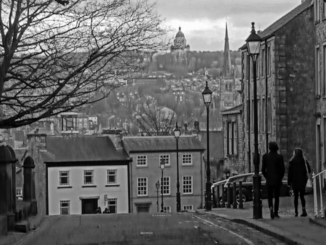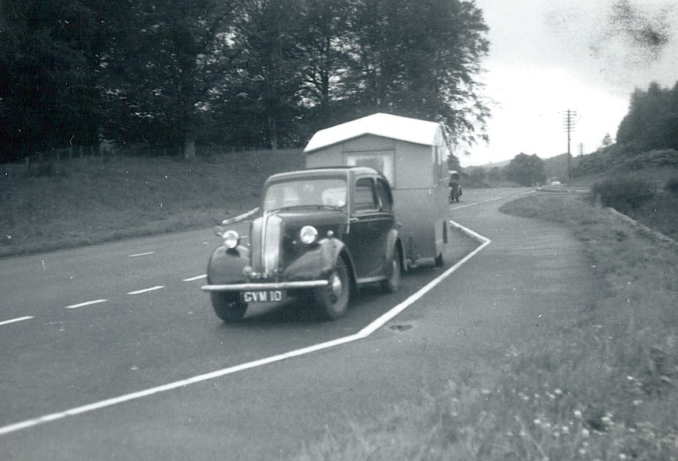
© Always Worth Saying 2023, Going Postal
In 1957, Scotland was undergoing significant social and economic change. The post-war years had seen a boom in heavy industry, particularly in shipbuilding and steel production, but by the late 1950s, this growth was beginning to slow. The country was also experiencing a rise in nationalism, with the Scottish National Party gaining ground in local elections. In popular culture, Scottish music and dance were enjoying a resurgence, with the Edinburgh Festival becoming a major international event. However, many Scottish communities still faced poverty and social inequality, particularly in rural areas.
Meanwhile, Britain in general was in the midst of the post-war period of reconstruction and recovery. The economy was growing, and the country was experiencing a cultural shift with the rise of rock and roll music. The monarchy was also in the spotlight, with Queen Elizabeth II celebrating her fifth year on the throne. Politically, the Conservative Party led by Prime Minister Harold Macmillan was in power as the country dealt with the aftermath of the Suez Crisis.
Overall, 1957 was a year of change and progress for Britain as it continued to rebuild and redefine itself in the post-war era not least through the emergence of a skilled lower middle-class passing upon Franco’s Spain and post-war Switzerland and striking out on a summer tour of Scotland in their Ford Prefect and somewhat modestly proportioned caravan.
We shall assume my grandparents headed north from Carlisle to Stirling, one of many cities claiming to be ‘The Gateway to the Highlands’, and then continued further north – destination the River Dochart which carves a useful route between Loch Tay and the west coast.
Dochart Falls, Killin
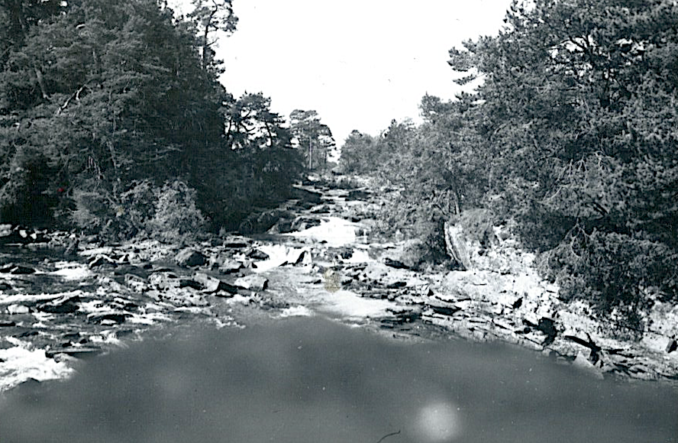
© Always Worth Saying 2023, Going Postal
The Falls of Dochart is a stunning waterfall located in the small town of Killin, which is in the Loch Lomond & The Trossachs National Park in Scotland. The falls are formed by the River Dochart, which flows east from Loch Dochart and becomes a waterfall as it reaches Killin, where its bed broadens and gradient becomes steeper. The falls are known for their extreme variability, ranging from a low flow to a raging torrent that covers the rocks. The best views of the falls can be obtained from the old stone Bridge of Dochart which crosses the river or from the rocky shoreline. The flow narrows and is directed through four channels crossed by the bridge which are bracketed by the Old Mill and the Falls of Dochart Inn. Downstream of the bridge is an island that is home to the Clan MacNab Burial Ground.
Our family photo is taken from the bridge. You can have a look around in the modern day by clicking on the following link. Puffins baffled by the still pool before the camera will notice upon close inspection that this is a fault on the emulsion of the photograph. Notice how everything suddenly loses focus at the edge of the darker part.
Oban
Our travellers reach the coast at Oban, ‘The Gateway to the Isles’. The beautiful west-coast holiday town is also known as ‘The Seafood Capital of Scotland.’ It has a population of around 8,500 people and is considered the unofficial capital of the West Highlands. The town offers stunning views of the islands of the Inner Hebrides, as well as the mountains, lochs, and castles in the area. Visitors can explore numerous castles, including the ruined Dunollie Castle. Oban’s bay is famous for its perfect horseshoe shape, which also offers spectacular views. The town has been a popular tourist destination since 1812 when the Comet steamship linked Oban with Glasgow. Queen Victoria personally enjoyed the town and called it “one of the finest spots we have seen”. Despite its small size, Oban is the largest town between Helensburgh and Fort William.

© Always Worth Saying 2023, Going Postal
Unfortunately, in our photograph, Oban Railway Station is obscured by a moored ferry and a harbourside goods shed. The terminus serves as the endpoint of the Oban Branch of the West Highland Line. The current station building was constructed in 1987-88, replacing an earlier, larger building, topped with an impressive multi-cantilevered roof. The station retains two open platforms that were originally built in 1904.
An important transportation hub since the 19th century, the first ferry service in Oban was established in the 1850s and was operated by local fishermen. In 1880, the Caledonian Steam Packet Company (CSP) took over the ferry operations and started offering regular services to the islands of Mull, Coll, Tiree, and Iona. The CSP continued to operate the ferry services until 1973 when it was nationalized and merged with other companies to form Caledonian MacBrayne (CalMac). Today, CalMac operates a modern fleet of ferries, connecting Oban to over 20 destinations in the Scottish Isles.
The MacBrayne company was founded by David MacBrayne, a Scottish ship owner who expanded a steamer service to the Inner and Outer Hebrides that was previously set up by J. & G. Burns. He later formed David MacBrayne Ltd, which had a virtual monopoly in transporting goods and passengers to and from the islands.
The vessel pictured is MacBrayne’s King George V, sometimes prefixed RMS (for Royal Mail Ship) and sometimes as TS (for Turbine Steamer).
She was built by William Denny and Brothers of Dumbarton for the Turbine Steamers Ltd company as a pioneering turbine-powered vessel intended for longer routes. Built in 1926, King George passed to the ownership of David MacBrayne Ltd in 1935, remaining there until withdrawal in 1974. The ship had seven turbines, a tonnage of 789 GRT and a speed of 16 knots. Several attempts were made to preserve her as a floating pub or restaurant but, having been burnt out in Cardiff docks in 1981, she was scrapped in 1984.
Above the harbourside scene, we spot McCaig’s Folly, a prominent Oban landmark, located on a hill overlooking the town. It was built by a wealthy banker named John Stuart McCaig in the late 19th century as a memorial to his family. The structure resembles a Roman colosseum and was intended to provide work for local stonemasons during a period of economic depression. Today, it is a popular tourist attraction and offers stunning views of the town and the surrounding islands.
John Stuart McCaig was born in 1823. The local Gas Works Director, he owned Oban Pier and became a successful banker with the North of Scotland Bank. Farmer’s son McCaig contested the 1885 general election as the Liberal Party candidate in the Argylshire constituency. His manifesto commitments included free breakfasts and disestablishing the Church of Scotland. To no avail, he was defeated at the polls by a Mr Donald Horne Macfarlane of the Crofter’s Party.
Glenfinnan
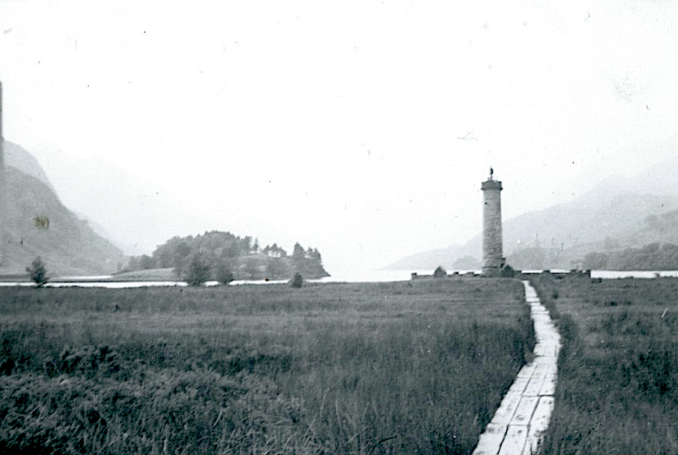
© Always Worth Saying 2023, Going Postal
As we head further north, presumably via Fort William and the foothills of Ben Nevis, we reach Glenfinnan, a small hamlet located in the Lochaber area. It is famous for being the site where the Jacobite rising began in 1745, when Bonnie Prince Charlie raised his standard on the shores of Loch Shiel. Nowadays, the area is a popular tourist destination, with visitors drawn to the 60ft tall Glenfinnan Monument, which was erected to commemorate this historic event.
The hamlet is also home to the Glenfinnan Viaduct, a 21-arch concrete structure that was built in 1898. On the West Highland Line linking Fort William and Mallaig, it is the longest concrete railway bridge in Scotland, measuring 415 yards long. The viaduct rises 100 feet above the ground and covers a 1,000-foot span which crosses the River Finnan.
The Fort William-Mallaig railway was one of the last major railway-building projects in the British Isles, completed in 1901. It is known for its scenic beauty and has become a popular tourist attraction. The journey time from Glasgow to Mallaig is approximately 5 hours and 30 minutes, while the journey time from Glasgow to Fort William is around 3 hours and 50 minutes.
The viaduct was constructed by Sir Robert McAlpine, 1st Baronet, also known as ‘Concrete Bob’. A Scottish businessman and builder, he founded the prominent British construction firm Sir Robert McAlpine. His nickname was earned via his pioneering innovations in the use of concrete and labour-saving machinery. He was involved in the construction of roads, public buildings, tunnels, and machinery. Besides overseeing the construction of the Glenfinnan Viaduct, he is known for expanding the harbour in Heraklion, Crete. McAlpine was made a baronet in June 1918, becoming the first of the McAlpine baronets. He died at sea on the MV Warwick Castle at the age of 87.
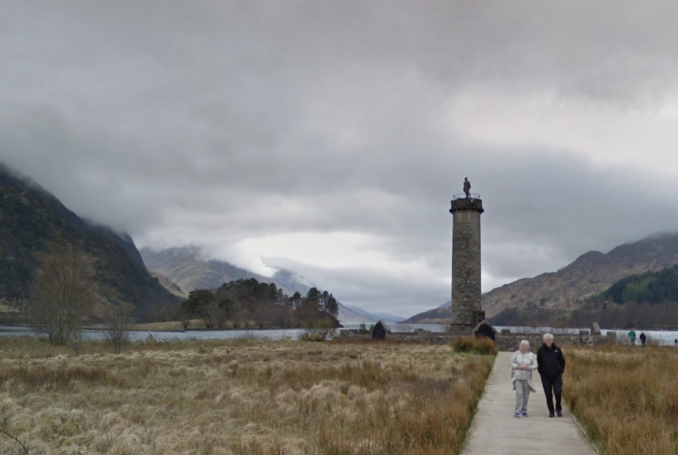
© Google Street View 2023, Google
In the modern day, despite the environmental catastrophe brought about by climate change, the vista is exactly the same (you can have a look around via this link) apart from the installation of a proper path in place of planks across the bog. Thank goodness for Concrete Bob and his kind!
© Always Worth Saying 2023

